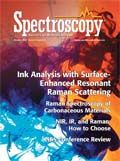Review of the Third North American Symposium on Laser-Induced Breakdown Spectroscopy (NASLIBS) 2011 Conference
Spectroscopy
This year's theme, "Transition from Research to Application," emphasized important developments in the field application of LIBS and fundamental knowledge of the technique.
Jose Almirall of Florida International University and Andrzej Miziolek of the US Army Research Laboratory present a review of the 2011 NASLIBS conference, which was held in Clearwater Beach, Florida, July 18–20.
The Third North American Symposium on Laser-Induced Breakdown Spectroscopy (NASLIBS) was held July 18–20, 2011, in Clearwater Beach, Florida, and by all accounts, it was a great success. NASLIBS 2011 was dedicated to capturing rapid developments in the fundamental science and applications of laser-induced breakdown spectroscopy (LIBS). A unique feature of this technique is the potential to make remote, real-time determinations of the chemical composition of any sample, whatever its nature or physical state, at close contact as well as at standoff ranges in excess of 100 m.
In the Program: Expert Discussions and Sessions
NASLIBS 2011 brought together 170 experts and young researchers in the field, specialists from analytical laboratories, and engineers from industries concerned with applications and instrument development to examine recent developments and define current needs. The central theme of NASLIBS 2011, "Transition from Research to Application," emphasized important developments in the application of LIBS in analytical chemistry including field applications and contributions in fundamental knowledge. In addition, developments in instrumentation, instrument control, and LIBS data analysis were highlighted. Progress in the development of several key applications of LIBS also were touched upon.
The NASLIBS 2011 program included three tutorial sessions, 15 invited oral presentations, and 24 additional contributed oral presentations, as well as 78 poster presentations from the participants. We are especially proud that 45 of the participants were students, most of whom were supported on travel grants from the Army Research Office (15 awards) and from Oak Ridge Associated Universities (ORAU) (13 awards).
Special Panel Discussion — LIBS in the Courtroom: Recent Examples and Future Potential
A highlight of the NASLIBS 2011 conference was the special panel devoted to the introduction of LIBS and other new technology into the courtroom. The audience heard from leading experts in new technology who have had the opportunity to present reports and testimony in cases involving LIBS and canine olfaction. A recent high-profile Florida case (the Casey Anthony murder trial) was highlighted by the presenters, two of which had involvement in the case.
The panelists were Madhavi Martin, senior scientist at Oak Ridge National Laboratory (ORNL) in Oak Ridge, Tennessee; Ken Furton, Dean, College of A&S at Florida International University in Miami, Florida; George Borghi, retired, Analytical Section, Miami Dade Police Department Forensic laboratory (Miami, Florida); John Lewoczko, ORAU, Quantico, Virginia; and Jose Almirall, Director of the International Forensic Research Institute (IFRI) at Florida International University in Miami, Florida. The panel was moderated by Andrzej Miziolek of the US Army Research Laboratory.
Additonal Conference Highlights
Several other highlights from this year's conference include
- increasing the use of LIBS for nuclear and radiological materials analysis, including isotopic specificity
- new results on using LIBS for pathogen identification
- instrument exhibit of the first person-portable battery-powered LIBS analyzer suitable for field studies
- progress in quantification of LIBS
- LIBS studies related to the upcoming mission to Mars
- analysis and identification of conflict minerals
- advances in the use of chemometrics.
The Future of NASLIBS
The scientific and executive committees of NASLIBS decided to merge the meeting with the Federation of Analytical Chemistry and Spectroscopy Societies (FACSS) conference starting in 2013. This important new development is a result of the maturation of the North American LIBS community and the desire for NASLIBS to expand the exposure of the scientific presentations. The committee also decided to create a society named North American Society of LIBS (NASLIBS) and organize the business of gathering in future meetings as a society. Applied Optics will publish a feature issue containing peer-reviewed manuscripts highlighting the papers presented during the NASLIBS 2011 conference. The Applied Optics special issue announcement can be found at www.opticsinfobase.org/ao/journal/ao/feature_announce/LIBS.cfm.
The final conference program and proceedings can be found on the conference website: www.icet.msstate.edu/naslibs2011.
Jose Almirall is a professor of chemistry and biochemistry at Florida International University in Miami, Florida, and was Program Chair for the NASLIBS 2011 conference.
Andrzej Miziolek is with the US Army Research Laboratory and was General Co-chair for the NASLIBS 2011 conference.

LIBS Illuminates the Hidden Health Risks of Indoor Welding and Soldering
April 23rd 2025A new dual-spectroscopy approach reveals real-time pollution threats in indoor workspaces. Chinese researchers have pioneered the use of laser-induced breakdown spectroscopy (LIBS) and aerosol mass spectrometry to uncover and monitor harmful heavy metal and dust emissions from soldering and welding in real-time. These complementary tools offer a fast, accurate means to evaluate air quality threats in industrial and indoor environments—where people spend most of their time.
NIR Spectroscopy Explored as Sustainable Approach to Detecting Bovine Mastitis
April 23rd 2025A new study published in Applied Food Research demonstrates that near-infrared spectroscopy (NIRS) can effectively detect subclinical bovine mastitis in milk, offering a fast, non-invasive method to guide targeted antibiotic treatment and support sustainable dairy practices.
Smarter Sensors, Cleaner Earth Using AI and IoT for Pollution Monitoring
April 22nd 2025A global research team has detailed how smart sensors, artificial intelligence (AI), machine learning, and Internet of Things (IoT) technologies are transforming the detection and management of environmental pollutants. Their comprehensive review highlights how spectroscopy and sensor networks are now key tools in real-time pollution tracking.